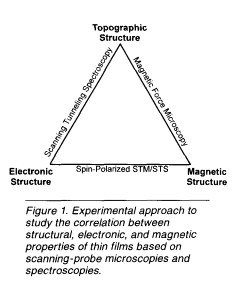Article contents
Correlation Between Nanoscale Structural, Electronic, and Magnetic Properties of Thin Films by Scanning-Probe Microscopy and Spectroscopy
Published online by Cambridge University Press: 29 November 2013
Extract
Heteroepitaxial pseudomorphic thin-film growth allows the stabilization of solids in structures—that is, with crystalline symmetries and lattice constants that are far from those of the corresponding bulk material. This facilitates the tailoring of materials properties that do not exist in nature. Usually a strong correlation is found between the atomic, electronic, and magnetic structure of thin films, which leads to a drastic dependence of their physical properties on the details of growth conditions such as substrate temperature, evaporation rate, and background pressure. To learn more about the fundamental relationship between structural, electronic, and magnetic properties of thin films as well as to improve the reproducibility of their physical properties in view of technical applications, it is mandatory to apply experimental techniques with sufficient, ultimately atomic spatial resolution combined with high sensitivity. The class of scanning-probe microscopies and spectroscopies is ideally suited for that purpose as schematically illustrated in Figure 1. Scanning tunneling spectroscopy (STS) establishes the correlation between atomic structure and local electronic properties, while spin-polarized scanning tunneling spectroscopy (SPSTS) relates local electronic and magnetic properties. Additionally the correlation

between topographical and magnetic structure can be addressed by magnetic force microscopy (MFM) though the spatial resolution is limited to about 10–50 nm. Since magnetic thin films are usually sensitive to oxidation, their preparation and characterization have to be performed in situ under ultrahigh vacuum (UHV) conditions in order to achieve reproducible experimental conditions. While STS is now routinely applied in UHV, it has only been recently that the first MFM studies under UHV conditions have been reported. In the following, representative examples of the application of STS, SPSTS, and MFM in ultrathin Fe, Gd, and Co films will be presented.
- Type
- Nanoscale Characterization of Materials
- Information
- Copyright
- Copyright © Materials Research Society 1997
References
- 6
- Cited by


